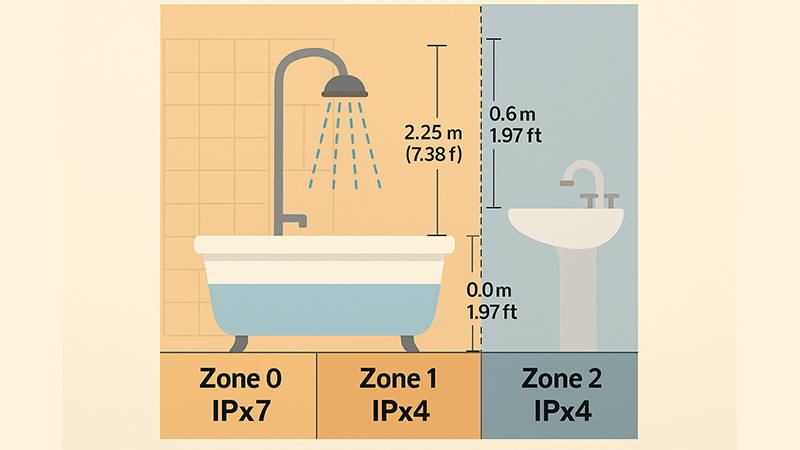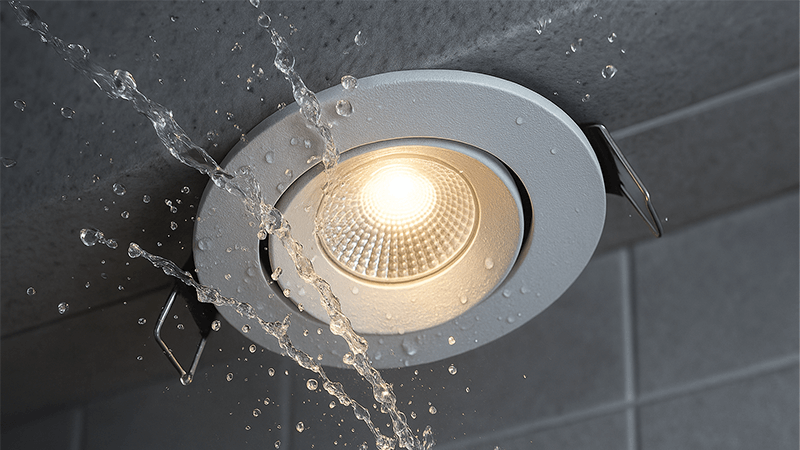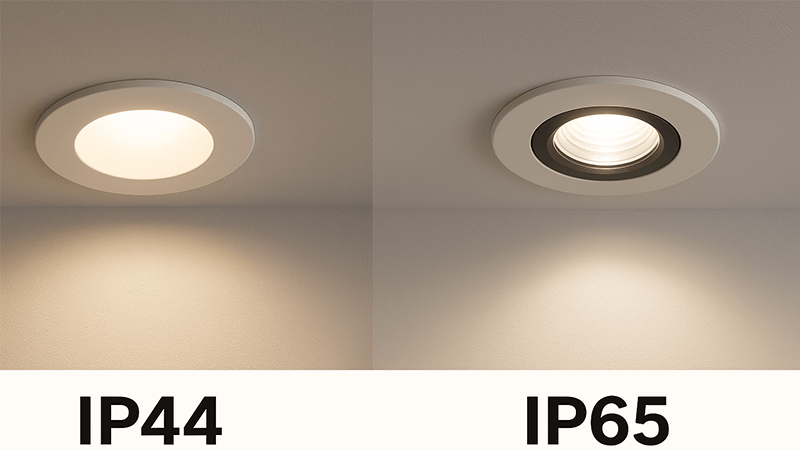Feeling unsure about bathroom lighting safety? The wrong choice risks damage and danger. IP65 ratings offer a clear solution for peace of mind in wet environments.
Yes, IP65 downlights are not only suitable but highly recommended for bathrooms. Their high level of protection against water jets and dust makes them ideal for areas with moisture, steam, and direct splashes, ensuring both safety and longevity.

So, we know IP65 is a good choice. But the details matter. There are specific zones within a bathroom, and each has different requirements. Let’s break down exactly where and why IP65 downlights are the right fit, and what you need to consider before you make a purchase. I’ve seen many projects succeed or fail based on these small details.
Can you use IP65 downlights in a bathroom?
Choosing lights for your bathroom project feels complicated. One wrong specification can cause delays or safety issues for your client. Using IP65 downlights simplifies the choice, meeting safety standards easily.
Absolutely. You can definitely use IP65 downlights in a bathroom. They are designed to be safe and durable in wet and humid conditions. This rating ensures the fixture is protected from water projected from any direction, making it perfect for the unique challenges a bathroom environment presents.

To understand this better, we need to talk about bathroom zones. Regulations in many countries divide a bathroom into different zones based on the risk of water exposure. This helps contractors and designers choose the right IP-rated fittings for each area.
Understanding Bathroom Zones
- Zone 0: This is inside the bath or shower tray itself. Any fitting used here must be low voltage (max 12V) and be rated at least IP67, which is total immersion proof.
- Zone 1: This is the area directly above the bath or shower, up to a height of 2.25m from the floor. Lights here must have an IP rating of at least IP44, but IP65 is highly recommended for better protection against shower sprays.
- Zone 2: This area covers a 0.6m radius around the bath, shower, or sink, and up to a height of 2.25m. A rating of at least IP44 is required here.
- Outside Zones: This was previously known as Zone 3. It’s any area outside of zones 0, 1, and 2. There is no specific IP requirement here, but I always suggest using at least IP20.
Given these zones, an IP65 downlight is a safe and robust choice for Zones 1 and 2. Many of my clients, like Shaz from the UAE, prefer to simplify their stock by specifying IP65 for all bathroom areas. This removes any risk of installing the wrong fitting in the wrong zone, ensuring safety and compliance across the entire project.
Is IP65 good for a bathroom?
You want a lighting solution that lasts. But bathroom humidity and steam can quickly ruin standard fixtures, leading to frequent replacements. An IP65-rated light is built to withstand these harsh conditions.
IP65 is an excellent rating for any bathroom. It provides a very high level of protection that often exceeds the minimum requirements. This means greater safety, a longer lifespan for the light, and more peace of mind for both you and your client.

Let’s dive deeper into what the IP65 rating actually means. The "IP" stands for Ingress Protection. The two numbers that follow have specific meanings.
Breaking Down the IP65 Rating
| Digit |
Meaning |
Protection Level for IP65 |
Implication for Bathrooms |
| First (6) |
Solids Protection |
6: Dust Tight |
No ingress of dust; complete protection against contact. This prevents small particles and steam vapor from entering the housing and damaging the electronics. |
| Second (5) |
Liquids Protection |
5: Water Jets |
Protected against water jets projected by a nozzle (6.3mm) from any direction. This easily handles steam, condensation, and splashes from sinks or showers. |
This high level of protection is why IP65 is so good for bathrooms. The dust-tight seal (the ‘6’) is crucial. It stops steam and airborne moisture from getting inside the fitting over time, which is a common cause of failure in lower-rated lights. The water jet protection (the ‘5’) means it can handle much more than just a bit of condensation.
One critical point I always stress to my partners is a practical installation check. Before you buy, you must measure the finished ceiling thickness, like the total height of the plasterboard and any wooden supports. You have to ensure the downlight’s required installation depth is less than this ceiling thickness. If the light is too tall for the ceiling void, it simply cannot be installed. This seems basic, but it’s a costly mistake I’ve seen happen. Checking this one measurement can save a lot of time and money on site.
Are IP65 lights safe for shower areas?
Placing lighting directly over a shower is a big safety concern. You worry about water getting into the fixture and causing a short circuit. This is a valid fear with standard lights.
Yes, IP65 lights are absolutely safe for use directly above a shower, within Zone 1. Their construction is specifically designed to prevent water ingress from powerful sprays. This makes them one of the most reliable choices for providing bright, safe illumination right where you need it most.

Safety is the number one priority in my business, and it should be in yours too. When we talk about shower areas, we are firmly in Zone 1. This area has the highest likelihood of being sprayed directly with water. Therefore, using a fixture rated for this environment is not just a suggestion; it’s a requirement for safety and electrical compliance.
Why IP65 Excels in Showers
- Direct Water Protection: The ‘5’ in IP65 means the fitting has been tested against water jets. A typical shower head delivers a spray that falls well within the testing parameters of this rating. You can be confident that no water will penetrate the light’s housing and reach the electrical components.
- Steam and Condensation Proof: Showers create a huge amount of steam. An IP65 downlight’s dust-tight seal is also incredibly effective at blocking steam. Over the years, I’ve seen many IP44 lights fail in shower cubicles because steam eventually found its way inside. The superior seal of IP65 prevents this long-term degradation.
- Material Durability: At iPHD, our IP65 downlights are made with materials that resist corrosion, like high-grade aluminum and durable powder coatings. Bathrooms are humid, and cheap materials will rust or discolor quickly. Quality materials ensure the fitting looks as good as it performs for years to come.
I remember a project with a hotel client who was renovating 200 bathrooms. They were considering IP44 downlights for the shower areas to save a little on cost. I explained the long-term risk of failure due to steam. We calculated the potential cost of replacing failed units and the disruption to their guests. They quickly agreed that specifying IP65 from the start was the smarter investment for safety, reliability, and their hotel’s reputation.
Is IP44 or IP65 better for bathrooms?
Choosing between IP44 and IP65 can be confusing. You want to meet regulations without overspending, but you also need a reliable product. Picking the wrong one could lead to premature failures.
For overall bathroom use, IP65 is better than IP44. While IP44 is acceptable for certain zones, IP65 offers superior protection against both dust and water. This enhanced durability makes it a safer, more reliable choice, especially for areas with direct water spray like showers.

Let’s do a direct comparison. Both ratings are used in bathrooms, but they are not interchangeable. Understanding their differences is key to making the right specification for your project. As a manufacturer, I see the internal differences in construction, and I can tell you the higher rating comes from better design and materials.
IP44 vs. IP65: A Head-to-Head Comparison
| Feature |
IP44 Rating |
IP65 Rating |
Which is Better for Bathrooms? |
| Solids Protection |
4: Protected against solid objects >1mm. |
6: Dust Tight. No ingress of dust. |
IP65. The dust-tight seal is far superior at preventing steam and fine moisture particles from entering the fitting over time. This is a major factor in longevity. |
| Liquids Protection |
4: Protected against splashing water from any direction. |
5: Protected against water jets from any direction. |
IP65. "Splashing water" is much less intense than "water jets." An IP65 light can handle direct spray from a shower head, while an IP44 light is only designed for indirect splashes. |
| Suitable Zones |
Zone 2 and Outside Zones. |
Zone 1, Zone 2, and Outside Zones. |
IP65. Its versatility allows it to be used safely in more areas, including directly above a shower. This simplifies purchasing and installation, as you can use one product for the entire bathroom. |
From my experience helping clients like Shaz, standardizing on IP65 for all bathroom projects is the most efficient strategy. It eliminates any confusion on-site about which fixture goes where. The installers can’t make a mistake if all the downlights have the highest necessary rating. The small additional upfront cost for IP65 over IP44 is easily justified by the increased safety, longer product life, and reduced risk of future maintenance calls. It’s an investment in quality and reliability that protects your business and keeps your customers happy.
Conclusion
In short, IP65 downlights are an excellent and safe choice for bathrooms. They provide superior protection in wet and humid zones, ensuring reliability, safety, and a long operational life.